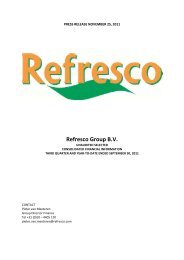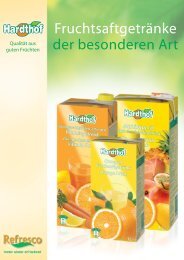You also want an ePaper? Increase the reach of your titles
YUMPU automatically turns print PDFs into web optimized ePapers that Google loves.
amortized cost, using the effective interest method, less any<br />
impairment losses.<br />
Derivative financial instruments<br />
The Group holds <strong>de</strong>rivative financial instruments to hedge its<br />
foreign currency and interest rate risk exposures. Derivatives<br />
are recognized initially at fair value and attributable transaction<br />
costs are recognized in profit or loss when incurred. Subsequent<br />
to initial recognition, the <strong>de</strong>rivatives are measured at fair<br />
value. All changes in its fair value are recognized immediately in<br />
profit or loss. Where the financial instruments are held to hedge<br />
foreign currency purchases of raw materials and consumables,<br />
the changes are inclu<strong>de</strong>d in raw materials and consumables<br />
used. Where the instruments are held to hedge interest rate<br />
risk exposure, the changes are inclu<strong>de</strong>d in finance income and<br />
expense.<br />
2.4 Share capital<br />
Ordinary share capital<br />
Ordinary share capital is classified as equity. Incremental costs<br />
directly attributable to the issue of ordinary shares and share<br />
options are recognized as a <strong>de</strong>duction from equity, net of any tax<br />
effects.<br />
Preference share capital<br />
Preference share capital is classified as equity if it is non-re<strong>de</strong>emable,<br />
or re<strong>de</strong>emable only at the Company’s option, and any<br />
divi<strong>de</strong>nds are discretionary. Divi<strong>de</strong>nds thereon are recognized<br />
as distributions within equity upon approval by the General<br />
Meeting of Sharehol<strong>de</strong>rs.<br />
2.5 Property, plant and equipment<br />
Recognition and measurement<br />
Items of property, plant and equipment are measured at cost<br />
less accumulated <strong>de</strong>preciation and accumulated impairment<br />
losses. Cost inclu<strong>de</strong>s expenditure that is directly attributable to<br />
the acquisition of the asset. The cost of self-constructed assets<br />
inclu<strong>de</strong>s the cost of materials and direct labor, any other costs<br />
directly attributable to bringing the assets to a condition suit-<br />
able for their inten<strong>de</strong>d use, and the costs of dismantling and<br />
removing the items and restoring of the site on which they are<br />
located. Borrowing costs that are directly attributable to the<br />
acquisition or construction of a qualifying asset are recognized<br />
in profit and loss when incurred.<br />
When elements of an item of property, plant and equipment<br />
have different useful lives, they are accounted for as separate<br />
items (major components) of property, plant and equipment.<br />
Gains and losses on disposal of an item of property, plant and<br />
equipment are <strong>de</strong>termined by comparing the net proceeds of<br />
disposal with the carrying amount and are recognized on a net<br />
basis in other income in profit or loss.<br />
Subsequent costs<br />
The cost of replacing part of an item of property, plant and<br />
equipment is recognized in the carrying amount of the item<br />
if it is probable that the future economic benefits embodied<br />
within the part will flow to the Group and its cost can be<br />
measured reliably, the carrying amount of the replaced part<br />
is <strong>de</strong>recognized. The costs of the day-to-day maintenance of<br />
property, plant and equipment are recognized in profit or loss<br />
as incurred.<br />
Depreciation<br />
Depreciation is recognized in profit or loss on a straight-line<br />
basis over the estimated useful lives of each element of an<br />
item of property, plant and equipment. Land is not <strong>de</strong>preciated.<br />
The estimated useful lives for the current and comparative<br />
periods are as follows:<br />
Buildings : 25 years<br />
Machinery and equipment : 5-10 years<br />
Other fixed assets : 3-10 years<br />
Depreciation methods, useful lives and residual values are<br />
reviewed at each reporting date.<br />
page _ 70 / 71







